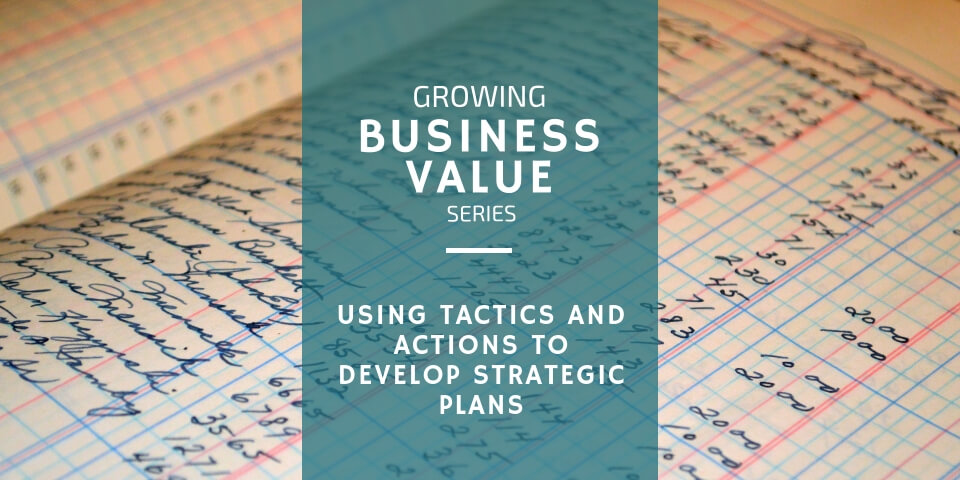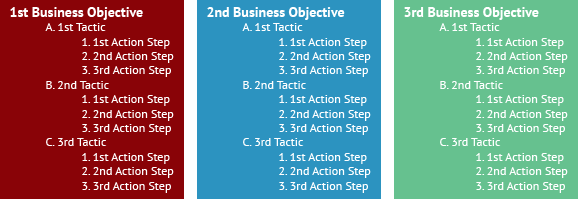
3 Questions to Ask When Developing Strategies to Meet Business Goals
December 24, 2018
10 Ways to Train Employees to Become Leaders
December 28, 2018Tactics and Actions…How to Implement Your Strategic Plans

Of the 8 foundational components that drive up your business’s value, 6 are functioning divisions within your company. Here’s what I mean by that. Leaders make plans; leaders and planning aren’t business departments. You, as business owners, give plans to your sales, marketing, HR, operational, accounting, and legal departments to follow. Thus, the team members in those 6 departments implement your plans. Without action and implementation by those functioning divisions, plans cannot become realities. So once you’ve developed strategies to meet your business growth objectives, it’s time for your team members to help you come up with the short-term tactics and actions necessary to accomplish your long-term objectives.
Podcast Time Index for “Tactics & Actions in Strategic Planning”
- 00:32 – Strategic Planning: Tactics & Actions
- 01:55 – Strategies for your business’s Objectives
- 02:27 – Tactics for the Objectives
- 03:43 – Those that plan the Tactics need to be actively involved
- 05:40 – Objectives, Tactics & Actions
- 06:53 – Actions implement Tactics
- 08:57 – 3 Objectives x 3 Tactics x 3 Actions
- 11:26 – Example
- 12:39 – Wrap-Up
If you’ve been following this mini-series on the strategic planning process, you’re familiar with the acronym VMVSOSTA. I’ve discussed creating overarching Vision and Mission statements that will outline the future growth of your company and align with your Values. Then, I taught you how to do a SWOT Analysis with your team members so that you can set 3 achievable Objectives for your business’s growth. In the most recent article, I showed you how to develop Strategies, or plans, that would help you meet those Objectives within 3 years. Now, I want to flush out the strategies. I want to show you how to implement your strategic plans.
Bring in Your Team Members
Once you and your management team have set goals and developed long-term plans to meet those goals, it’s time to bring in your team members – the ones doing the day-to-day work of the company. Now is the time to share your business objectives and get feedback. However, you’re not asking your team members whether or not they agree with your goals. Obviously, you want them to buy into your holistic vision, mission, and objectives. That’s imperative if you want them to work with you. In this instance, though, you want them to help you determine ways to accomplish your goals. Another way I could illustrate this concept is in this manner. You, the business owner are determining the “What” and “Why” of your business and you are seeking the expertise of your team to help you with the “How”.
Your team members are in the “trenches” of your business, so to speak. They know the processes and procedures that keep your company running like a well-oiled machine. If they understand your goals, they can show you “How” to reach them. Furthermore, your team members will know “Who” should work on each created task and actionable step. So, they’re the best ones to help you create tactics and actions.
Tactics and Actions – The Implementation of Strategic Planning
Then, what exactly are tactics and actions in the strategic planning process? Well, they’re the short-term, bite-size, measurable steps you and your team members are going to take to achieve your long-term business growth goals. Essentially, your tactics and actions are your team’s “To Do List.” Usually, tactics are the steps you’ll take in a year’s time frame, and actions are the steps you’ll take quarterly, monthly, and/or weekly.
Let’s break that down even further, sticking to the power of 3. First, I recommended that you create 3 business objectives. Then, I think you should develop 3 tactics to accomplish each of the 3 goals you’ve set. Finally, I advise my clients to write down 3 action steps to take to accomplish each tactic. This image shows you how objectives, tactics, and actions work together.

Using Objectives, Tactics, and Actions in Your Business
If you follow the methodology I outlined, you’ll end up with 3 different tactics and 9 different action steps per objective. Let me give you some real-life, but hypothetical examples of how this works. I’ve merely given ideas to show you how objectives, tactics, and actions work together; I’m not recommending that you follow any of them. Please consult your Certified Value Growth Advisor™ or Business Coach to create objectives, strategies, tactics, and actions that will work best for your business.
Let’s say that one of your business objectives is to increase your company’s profit margins by 20%. (Remember, one objective must be financial!) How will you do that… what’s your strategy? Well, to increase your company’s profit margins, you’re going to have to increase sales and decrease expenses. So WHAT exactly are you going to do, and WHO is going to do it?
I. 1st Objective – Increase profit margins by 20%
A. 1st Tactic – Increase brand awareness
1. 1st Action – Social media team to incorporate company logos in all posts
2. 2nd Action – Marketing team to create new product packaging with the company logo
3. 3rd Action – Floor team to repackage products with newly branded materials
B. 2nd Tactic – Decrease expenses by 5%
1. 1st Action – Finance department to audit corporate expenses to find and eliminate frivolous spending
2. 2nd Action – Owners to review insurance options and pricing with an agent
3. 3rd Action – Business manager to renegotiate vendor costs and contracts.
C. 3rd Tactic – Increase sales by 5%
1. 1st Action – Marketing team to create an advertising campaign to show off slow-moving products
2. 2nd Action – Sales team to bundle related products into sellable packages
3. 3rd Action – Owners to add a commission incentive for salespeople who sell $X in a week’s time frame.
BUSINESS RESOURCES: download the Financially Simple Strategic Planning Worksheets
Tactics and Actions Matter to Strategic Planning
Your tactics will remain the same throughout the year, but your action steps can be accomplished more quickly than that. You can accomplish some of your action steps within a week, a month, or a quarter’s time frame. Therefore, once you cross an action off your “To-Do List,” create a new action step to take its place.
Unless you create super specific, measurable steps to follow, you’ll take no steps forward. And if you’re working to grow the value of your company, then you must move forward. Strategic planning helps you clarify your vision and mission, identify your current state of affairs, clarify your objectives, and take action steps to achieve your objectives. It helps you move forward, growing the value of your company. So with that, I’m going to wrap up the mini-series on strategic planning. Now that you understand how important strategic planning is for your company’s growth and how to implement it within your business, it’s time to discuss the 2nd fundamental area of your business – leadership.
Hey, we get it… strategic planning is tough, even for seasoned and highly-trained professionals like us. But we have lead many a business through this process and we can help you too. Schedule a call with our team.



